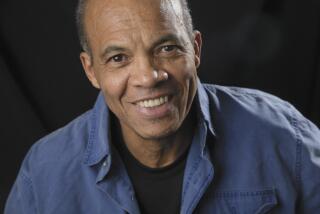How Héctor Tobar turned a real-life gringo Che Guevera into the hero of his new novel
- Share via
If you buy books linked on our site, The Times may earn a commission from Bookshop.org, whose fees support independent bookstores.
The first time Héctor Tobar and I ate together, we discussed Joe Sanderson. This was in 2009, after Tobar returned to California from Mexico City, where he’d been The Times’ bureau chief. Later, he and I would spend two years working together on the paper’s book section.
Tobar’s fifth book, “The Last Great Road Bum,” circles back to that initial conversation; it’s a novel about Sanderson, an American from Illinois who in the 1980s fought alongside the rebels in the Salvadoran civil war. Sanderson was a prolific writer, if not a particularly skilled one, and his manuscripts and correspondence sit at the center of Tobar’s account. At the same time, the decision to frame his story as a work of fiction creates a set of exhilarating tensions, especially in a series of footnotes written from Sanderson’s perspective. (Spoiler: He’s got some issues with the book.)
The Times caught up with Tobar via Zoom on a sweltering August morning. He was in Winslow, Ariz., the first stop on a cross-country road trip to bring his college-age son back East for school.
A long-lost diary sheds light on the final days of Joe Sanderson, a man who craved adventure. His last one would cost him his life.
How did you find out about Joe Sanderson?
When I was the Mexico City bureau chief, I had this fixer-researcher in San Salvador, and one day he called to tell me he had heard about a diary in the possession of the Museum of the Revolution. It was the diary of a guy from Illinois named Joe Sanderson. He was killed fighting with the rebels in El Salvador, and he had a diary in his backpack when he died. My first impression was that it was a gringo equivalent of Che’s Bolivian diary. I started to write a proposal for a nonfiction book.
Had you written your L.A. novel, “The Barbarian Nurseries,” yet?
I was halfway through. I called my agent and told him about this project. He said, “Go ahead and finish the novel,” which was also what I wanted to do. In fact, I ended up publishing “Deep Down Dark” [about trapped Chilean miners] before I got back to this. But when I started writing the proposal for this book as nonfiction, it didn’t sing to me. So I had to figure out something else.
Had you set this story completely aside?
I was continually doing small things to research the project. I went to Champaign-Urbana, where Joe was born and raised. I don’t think I’d ever been to a Midwestern college town. I was enchanted. It was this incredible little metropolis of stone buildings, surrounded by corn, with a beautiful river running through it and cicadas singing in the trees. I interviewed Joe’s father, Milt, who was 100 years old. The world’s leading expert on the June beetle, a respected entomologist. We spoke for four or five days and a lot of the emotional universe of the book was born in those conversations.
How much of that emotional universe had to do with your being a father?
This book coincided with the teenage years of my two sons, and with those sons going away to college. So I used that, especially in regard to Joe’s mother, who I never met. She died in 1986. I gave her all those little moments you have with your children as they become adults. There’s a scene when Joe returns from El Salvador and has a meal with his mother. Then he leaves again, and she’s alone with the leftovers in the refrigerator. That’s a moment from my life I gave to Virginia Sanderson.
When did you begin to imagine the book as a novel?
I knew the miners book was going to be the big nonfiction book of my career. I started to think that if I did another nonfiction book, I might never write a novel again. So there was artistic self-interest, which is an excellent place to start. Then I thought: “Oh, my God. This crazy guy Joe. Here’s a guy who died trying to write a novel by living his life like a character in a novel. Maybe I should write a novel about him.”
Drawing on testimonies from rebels, Marjoleine Kars’ riveting “Blood on the River” recounts an 18th century revolt in Guyana that almost succeeded.
I’m fascinated by the decision to give Joe a voice in the footnotes.
I was afraid, to be perfectly honest, that I was not going to keep a lot of readers under 40, because literature has changed since Joe tried to write. I needed to address the fact that this is not the same world he lived in. We have different ideas about the role of women and people of color and literature. I wanted the book to be true to Joe’s time but honest for these times, as well. So the footnotes became a way of dealing with that contradiction. How is it that I am a writer of color and writing a book about this white guy?
The book sits between journalism and fiction, and you’re a practitioner of both. How did that double vision expand your sense of narrative?
At the beginning, I saw Joe as an adventurer. I’ll never forget the first time I realized that Joe had taken two journeys around the world even before he got to El Salvador. He had been to Biafra. He had been in Yemen after their civil war. He had been in South Africa during apartheid and in Vietnam after the Tet Offensive. He had gone to the DMZ. He shows up everywhere. I thought: “This is an opportunity for me to circle the globe as a novelist.”
But as time went on, it became clear that the relationship with his mother was the anchor to the book. I had to take that seriously. I re-read Marilynne Robinson’s “Gilead” to get a sense of that white Midwestern experience.
It’s an American novel in the broadest sense.
Among my motivations was to bring the Salvadoran revolution into American literature. I think Joe’s ambition when he went to El Salvador was to write “For Whom the Bell Tolls.” He was going to be the American fighting the fascists. And that’s what he was. I wanted the accomplishment of my novel to be that it brought the Central American aesthetic, the Central American reality, into a Midwestern home.
Andrew Altschul’s novel is based on the true story of imprisoned expat Lori Berenson
Ulin is a former book editor and book critic of The Times.
More to Read
Sign up for our Book Club newsletter
Get the latest news, events and more from the Los Angeles Times Book Club, and help us get L.A. reading and talking.
You may occasionally receive promotional content from the Los Angeles Times.






